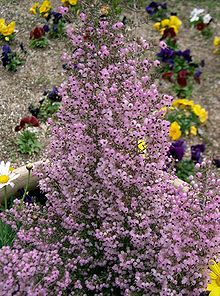
Erica arborea, the tree heath or tree heather, is a species of flowering plant (angiosperms) in the heather family Ericaceae, native to the Mediterranean Basin and Ethiopia, Kenya and Tanzania in East Africa. It is also cultivated as an ornamental.

Erica is a genus of roughly 857 species of flowering plants in the family Ericaceae. The English common names heath and heather are shared by some closely related genera of similar appearance. The genus Calluna was formerly included in Erica – it differs in having even smaller scale-leaves, and the flower corolla consisting of separate petals. Erica is sometimes referred to as "winter heather" to distinguish it from Calluna "summer heather".

Daboecia, or St. Dabeoc's heath, is a small genus of flowering plants in the family Ericaceae, containing two evergreen shrubs, closely related to the genus Erica. They are native to cliffs and heathland in southern Atlantic Europe and the Azores.

Molinia caerulea, known by the common name purple moor-grass, is a species of grass that is native to Europe, west Asia, and north Africa. It grows in locations from the lowlands up to 2,300 m (7,546 ft) in the Alps. Like most grasses, it grows best in acid soils, ideally pH values of between 3.5 and 5, however, it can continue to live under more extreme conditions, sometimes to as low as 2. It is common on moist heathland, bogs and moorland throughout Britain and Ireland. Introduced populations exist in northeastern and northwestern North America.

Erica vagans, the Cornish heath or wandering heath, is a species of flowering plant in the family Ericaceae, native to Ireland, Cornwall, western France and Spain. It is a vigorous, spreading, evergreen heather reaching 75 cm (30 in) tall and wide, with pink flowers borne in racemes 14 cm (6 in) long in summer and autumn. The Latin specific epithet vagans literally means "wandering"; in this context it means "widely distributed".

Erica cinerea, the bell heather, is a species of flowering plant in the heath family Ericaceae, native to western and central Europe.

Erica carnea, the winter heath, winter-flowering heather, spring heath or alpine heath, is a species of flowering plant in the family Ericaceae, native to mountainous areas of central, eastern and southern Europe, where it grows in coniferous woodlands or stony slopes.

Senecio macroglossus, the Natal ivy, marguerite ivy, climbing senecio or wax ivy, is a species of flowering plant in the family Asteraceae, native to southern Africa, from Zimbabwe and Mozambique to eastern South Africa.

Aloe arborescens, the krantz aloe or candelabra aloe, is a species of flowering succulent perennial plant that belongs to the genus Aloe, which it shares with the well known and studied Aloe vera. The specific epithet arborescens means "tree-like". Aloe arborescens is valued by gardeners for its succulent green leaves, large vibrantly-colored flowers, winter blooming, and attraction for birds, bees, and butterflies.

Ligustrum lucidum, the broad-leaf privet, Chinese privet, glossy privet, tree privet or wax-leaf privet, is a species of flowering plant in the olive family Oleaceae, native to the southern half of China and naturalized in many places. The name "Chinese privet" is also used for Ligustrum sinense.

Erica lusitanica is a European species of flowering plant in the family Ericaceae, known by the common names Portuguese heath and Spanish heath.

Melianthus major, the giant honey flower or kruidjie-roer-my-nie, is a species of flowering plant in the family Francoaceae. It is an evergreen suckering shrub, endemic to South Africa and naturalised in India, Australia and New Zealand. It grows to 2–3 m (7–10 ft) tall by 1–3 m (3–10 ft) wide, with pinnate blue-green leaves 30–50 cm (12–20 in) long, which have a distinctive musky odour. Dark red, nectar-laden flower spikes, 30–80 cm (12–31 in) in length, appear in spring, followed by green pods. All parts of the plants are poisonous.

Oscularia deltoides, the deltoid-leaved dewplant, dassievygie or sandsteenvygie is a species of flowering succulent plant in the fig-marigold family Aizoaceae that is native to the south-western Cape, South Africa.

Prostanthera cuneata, commonly known as alpine mint bush, is a species of flowering plant in the mint family Lamiaceae, and is endemic to mountainous areas of south-eastern continental Australia. It is an erect, compact shrub with egg-shaped leaves with the narrower end towards the base, and pale lavendar to almost white flowers with purple blotches.
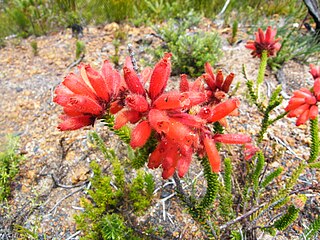
Erica cerinthoides is a species of heath native to South Africa, Lesotho and Eswatini. Common names include fire erica, fire heath, red hairy heath, rooihaartjie or klipheide. Throughout its range the species shows marked variation in habit, flower characteristics and hairiness. A form with white flowers is found in Eswatini and the South African province of Mpumalanga while the variety E. cerinthoides var. barbertona has shorter flowers.
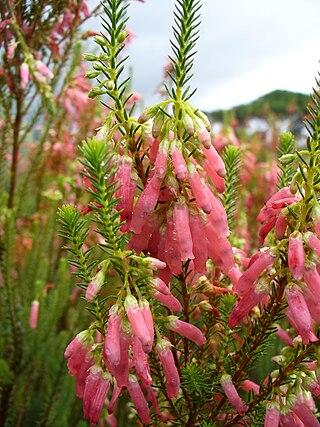
Erica mammosa, the nine-pin heath, is a species of flowering plant in the family Ericaceae, that is naturally restricted to the southwestern corner of the Western Cape, South Africa.
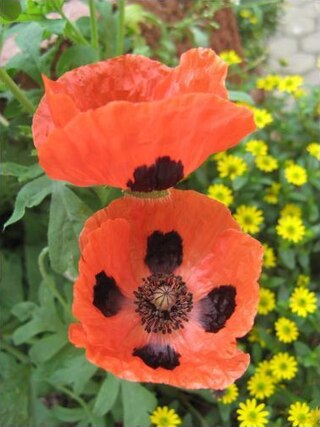
Papaver commutatum, the Caucasian scarlet poppy, is a species of flowering plant in the family Papaveraceae native to northern Turkey, northwestern Iran and the Caucasus. It is an erect annual growing to 45 cm (18 in) tall by 15 cm (6 in) wide, with hairy stalks and leaves. The flower is bowl-shaped and about 8 cm (3 in) in diameter, bright red with prominent black blotches at the bases of the petals, and is borne in early summer. The flowers are followed by spherical seed heads.
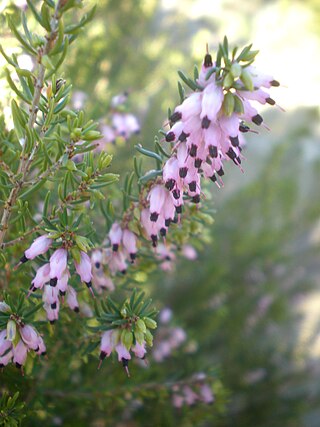
Erica erigena, the Irish heath, is a European species of flowering plant in the family Ericaceae.

Erica australis, the Spanish heath or Spanish tree heath, is a European species of flowering plant in the family Ericaceae.
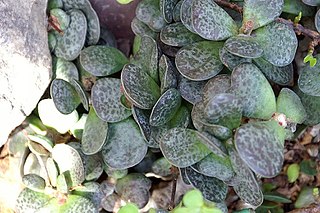
Adromischus maculatus, the spotted adromischus or calico hearts, is a species of flowering plant in the family Crassulaceae, which is endemic to the Eastern Cape and Western Cape of South Africa.
